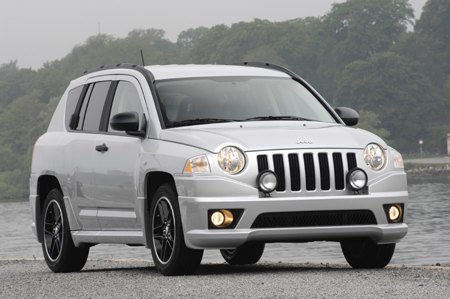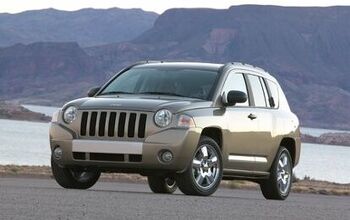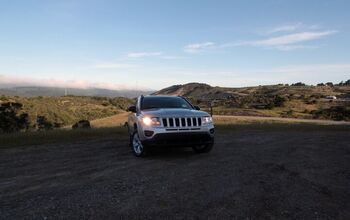Jeep Compass Review
Since Chrysler acquired AMC from Renault in ‘87, the Jeep brand has been the domestic manufacturer’s canary in the coal mine. When Jeep’s done well, Chrysler’s done well. When Jeep’s languished, Chrysler’s tanked. Chrysler’s German masters are not blind to this correlation. Jeep's new corporate parent has shortened product development cycles from decades to six years. And now Doktor Z und ze Boyz are looking to grow DaimlerChrysler by expanding Jeep's model lineup. Does the Compass point the way to a bright future for "America's sports car"?
The Compass is not the Jeep brand’s first non-Trail Rated product by any means (any 4X2 won’t do), but it’s become the most notorious. In an attempt to imbue the suburban schlepper with some brand faithful (if faux) off-street cred, the Compass’ designers maintained the classic Jeep proportions and gave it the usual brand cues: bug eyes, Iron Man mouth, seven-nostril nose and trapezoidal wheel arches. It just doesn’t work. The Compass’ triangular D-pillar kink strikes the most discordant note in a distinctly off-key, Far Eastern melody.
The Compass’ interior consists of DCX’ all-too-familiar homage to rectangles, punctuated by the occasional round dial or gauge. A gaping maw violently interrupts the passenger side dashboard, luring a mess of unsightly and unsecured schmutz which no right-minded off-roader would allow. It’s a workmanlike (though not workingmanlike) cabin, rescued from complete vapidity by two-tone leather seat and an [optional] MP3-compatible nine-speaker Boston Acoustics sound system that pumps-out major tuneage.
Equally strange, the Compass’ rear seats signal the vehicle’s inability to carry three adults in lateral comfort by leaving the two-tone design off the middle pew. A brace of rear passengers can recline– or you can forget the whole thing, fold the seats flat and stow the requisite mountain bikes, surfboards, golden retriever and other lifestyle gear. Oh, and the Compass’ rear cargo light is a detachable flashlight whose loss is your local Jeep dealer’s parts department’s endless gain.
The Compass’ 2.4-liter powerplant comes courtesy of the Global Engine Manufacturing Alliance (GEMA). This partnership of DaimlerChrysler, Hyundai and Mitsubishi has produced a so-called “World Engine.” Regrettably, this east-meets-west design– a Hyundai-designed block topped by a Mercedes-Benz-derived head — fails to deliver a first-rate competitor.
Though thrifty (estimated EPA economy 24/27 mpg), the transverse-mounted, 172hp DOHC 16-valve four-cylinder engine is completely intimidated by the Compass’ 3,153 pound curb weight (front wheel-drive model). Peak horsepower and torque arrive at 6000 and 4400 rpm respectively. Translation: a Compass driver must whip the snot out of the engine to liberate anything even remotely resembling hustle. Drop the hammer and the Compass moseys to 60mph in nine point five seconds. It takes an additional twenty three seconds to increase that velocity by 40mph. By then you’re bored witless and more or less finished.
The Compass’ Continuously Variable Transaxle (CVT) utilizes six preset gear ratios to simulate toothed cogs. During normal driving, the driver can manually input a “gear” by toggling the shift knob. Under hard acceleration, the computer controlled CVT jumps abruptly to a lower gear ratio, simulating a downshift. Under full throttle, the engine climbs to 6000 revs. And there it stays, while the Compass [slowly] accelerates. Now how much would you pay? The CVT costs $1150 and saps three mpg from maximum fuel efficiency. The Compass' standard five-speed manual gearbox is the better [non] option, but one suspects the Not Ready for Prime Time CVT will get the lion’s share of the business– and brickbats.
Never mind the TV ads. The Compass is far too tall, heavy and slow to offer sporty handling, or even the idea of sporty handling. If you have enough patience (and road) to attain speeds sufficient to generate lateral G’s, the Compass’ body motions are generally well controlled by its four-wheel independent suspension. The four-wheel discs haul the baby Jeep down from speed with admirable alacrity. The ride quality is acceptable: a cut above Jeep Liberty harshness, but not quite up to Grand Cherokee standards.
As far as off-roading is concerned, this Jeep doesn’t jeep. The Compass’ 8.1” ground clearance is competitive for a crossover ‘Ute. But a 20-degree approach angle will keep the Compass on the pavement or well maintained dirt roads. Even with the optional Freedom Drive I pack– a single-speed, electronically controlled all-wheel-drive system– the Rubicon would eat the Compass for breakfast.
And? The Jeep Compass will find plenty of budget-minded consumers looking to buy a piece of the Jeep mystique for peanuts (under $16k base); buyers who’d no more drive the Rubicon than raft down the Zambezi. Sure, Jeep will sell loads of Compasses, but at what price? In the long term, this is exactly the kind of half-hearted down market brand extension that dragged Mercedes’ image into the gutter.
More by William C Montgomery
Latest Car Reviews
Read moreLatest Product Reviews
Read moreRecent Comments
- V8fairy Not scared, but I would be reluctant to put my trust in it. The technology is just not quite there yet
- V8fairy Headlights that switch on/off with the ignition - similar to the requirement that Sweden has- lights must run any time the car is on.Definitely knobs and buttons, touchscreens should only be for navigation and phone mirroring and configuration of non essential items like stereo balance/ fade etc>Bagpipes for following too close.A following distance warning system - I'd be happy to see made mandatory. And bagpipes would be a good choice for this, so hard to put up with!ABS probably should be a mandatory requirementI personally would like to have blind spot monitoring, although should absolutely NOT be mandatory. Is there a blind spot monitoring kit that could be rerofitted to a 1980 Cadillac?
- IBx1 A manual transmission
- Bd2 All these inane posts (often referencing Hyundai, Kia) the past week are by "Anal" who has been using my handle, so just ignore them...
- 3-On-The-Tree I was disappointed that when I bought my 2002 Suzuki GSX1300R that the Europeans put a mandatory speed limiter on it from 197mph down to 186mph for the 2002 year U.S models.






































Comments
Join the conversation
[...] Sebring / Dodge Avenger* Dodge Caliber Dodge Nitro* Hummer H2* ** Hummer H3 / H3T* Jeep Commander Jeep Compass* ** Kia Amanti Lincoln Mark LT** Pontiac Torrent Saab 9-5 Scion xB smart fortwo Suzuki Forenza [...]
[...] her, and does indeed have a fertile womb. How special. In fact, Jeep even sells a car now that isn’t even trail rated! Nonetheless, despite all of this, Jeep does still sell the Wrangler – and this car is [...]